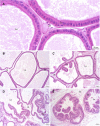Exposure to Dichlorvos pesticide alters the morphology of and lipid metabolism in the ventral prostate of rats
- PMID: 37469457
- PMCID: PMC10352615
- DOI: 10.3389/ftox.2023.1207612
Exposure to Dichlorvos pesticide alters the morphology of and lipid metabolism in the ventral prostate of rats
Abstract
Organophosphate pesticides are widely used in agriculture, leading to soil, water, and food contamination. Among these compounds is Dichlorvos [O,O-dimethyl O-(2,2-dichlorovinyl)phosphate, DDVP], which is listed as a highly toxic compound by the Environmental Protection Agency and World Health Organization. Exposure to DDVP can result in nervous, respiratory, hepatic, and reproductive abnormalities, in addition to endocrine disrupting, mutagenic, and carcinogenic effects. Little is known about the impacts of DDVP on the reprogramming of lipid metabolism, which is also associated with the development and progression of cancer, since the tumor cells need to recruit, capture, and use fatty acids to compose their building membranes. This study aimed to evaluate the influence of the pesticide DDVP on lipid metabolism in the prostate, after chemical induction by the carcinogen N-methyl-N-nitrosourea (MNU). For this, 32 Fischer rats aged 90 days were randomly divided into four experimental groups: Control, DDVP, MNU, and MNU + DDVP. The MNU and MNU + DDVP groups underwent chemical induction with MNU (15 mg/kg) and the DDVP and MNU + DDVP groups received a diet supplemented with DDVP (10 mg/kg). Histopathological analyses of the rat ventral prostate showed 100% incidence of epithelial hyperplasia in the MNU and MNU + DDVP groups. This finding was accompanied by an increase of the epithelial compartment in the MNU + DDVP group. Immunolocalization of important proteins linked to lipid metabolism has been established. In the MNU + DDVP group, Western blotting analyses pointed out an increased expression of the protein LIMP II (Lysosomal Integral Membrane Protein-II), which is correlated with the capture and distribution of lipids in tumor cells. Together, these results indicate that the association of a low dose of DDVP with MNU was able to promote alterations in the morphology and lipid metabolism of the rat ventral prostate, which may be related to tumor progression in this organ.
Keywords: CD36; Dichlorvos; LIMP-II; SCAP; SREBP; lipid metabolism; prostate cancer.
Copyright © 2023 Quintino-Ottonicar, Silva, Maria, Pizzo, Santana, Lenharo, Pinho and Pereira.
Conflict of interest statement
The authors declare that the research was conducted in the absence of any commercial or financial relationships that could be construed as a potential conflict of interest.
Figures





Similar articles
-
Cellular metabolism and health impacts of dichlorvos: Occurrence, detection, prevention, and remedial strategies-A review.Environ Res. 2024 Feb 1;242:117600. doi: 10.1016/j.envres.2023.117600. Epub 2023 Nov 7. Environ Res. 2024. PMID: 37939806 Review.
-
Moringa oleifera seed oil partially abrogates 2,3-dichlorovinyl dimethyl phosphate (Dichlorvos)-induced cardiac injury in rats: evidence for the role of oxidative stress.J Basic Clin Physiol Pharmacol. 2020 Nov 3;32(3):237-246. doi: 10.1515/jbcpp-2019-0313. J Basic Clin Physiol Pharmacol. 2020. PMID: 33141105
-
Protective effect of γ-tocopherol-enriched diet on N-methyl-N-nitrosourea-induced epithelial dysplasia in rat ventral prostate.Int J Exp Pathol. 2013 Dec;94(6):362-72. doi: 10.1111/iep.12042. Epub 2013 Oct 29. Int J Exp Pathol. 2013. PMID: 24205794 Free PMC article.
-
Emerging Technologies for Degradation of Dichlorvos: A Review.Int J Environ Res Public Health. 2021 May 28;18(11):5789. doi: 10.3390/ijerph18115789. Int J Environ Res Public Health. 2021. PMID: 34071247 Free PMC article. Review.
-
The pathway of 2,2-dichlorovinyl dimethyl phosphate (DDVP) degradation by Trichoderma atroviride strain T23 and characterization of a paraoxonase-like enzyme.Appl Microbiol Biotechnol. 2019 Nov;103(21-22):8947-8962. doi: 10.1007/s00253-019-10136-2. Epub 2019 Oct 14. Appl Microbiol Biotechnol. 2019. PMID: 31612268
Cited by
-
Non-alcoholic fatty liver disease: Role of PNPLA3 and its association with environmental chemicals.Arch Clin Toxicol (Middlet). 2024;6(1):21-32. doi: 10.46439/toxicology.6.029. Arch Clin Toxicol (Middlet). 2024. PMID: 40630828 Free PMC article.
-
Oral Administration of Lactiplantibacillus plantarum CCFM8661 Alleviates Dichlorvos-Induced Toxicity in Mice.Foods. 2024 Oct 9;13(19):3211. doi: 10.3390/foods13193211. Foods. 2024. PMID: 39410245 Free PMC article.
References
-
- Bosland M. C., Prinsen M. K., Dirksen T. J., Spit B. J. (1990). Characterization of adenocarcinomas of the dorsolateral prostate induced in Wistar rats by N-methyl-N-nitrosourea, 7,12-dimethylbenz(a)anthracene, and 3,2'-dimethyl-4-aminobiphenyl, following sequential treatment with cyproterone acetate and testosterone propionate. Cancer Res. 50, 700–709. - PubMed
LinkOut - more resources
Full Text Sources

